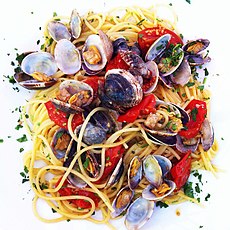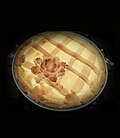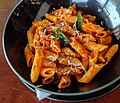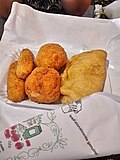Roman cuisine
 |
| Italian cuisine |
|---|
|
|
Roman cuisinecomes from theItaliancity ofRome.It features fresh, seasonal and simply-prepared ingredients from theRoman Campagna.[1]These includepeas,globe artichokesandfava beans,shellfish, milk-fed lamb andgoat,and cheeses such aspecorino romanoandricotta.[2]Olive oilis used mostly to dress raw vegetables, whilestrutto(porklard) and fat fromprosciuttoare preferred for frying.[1]The most popular sweets in Rome are small individual pastries calledpasticcini,gelato( "ice cream" ) and handmade chocolates and candies.[3]Special dishes are often reserved for different days of the week; for example,gnocchiis eaten on Thursdays,baccalà(salted cod) on Fridays, andtrippaon Saturdays.
History[edit]

Rome's food has evolved through centuries and periods of social, cultural, and political changes. Rome became a major gastronomical center during theancient age.Ancient Roman cuisinewas mainly based on cereals, cheeses, legumes and fruit.[4]Subsequently, the empire's enormous expansion exposed Romans to many new, provincial culinary habits and cooking techniques. In the beginning, the differences between social classes were not very great, but disparities developed with the empire's growth. Later, during theItalian Renaissance,Rome became well known as a center of high-cuisine, since some of the best chefs of the time worked for the popes. An example of this could beBartolomeo Scappi,who was a chef working forPius IVin the Vatican kitchen, reaching fame with his cookbookOpera dell'arte del cucinare,published in 1570. Here he lists approximately 1000 recipes of Renaissancecuisineand describes cooking techniques and tools, giving the first known picture of afork.[5] Roman and all Italian cuisine were transformationally influenced by the introduction of new world crops by the Spanish, especially the tomato.
Traditionalcucina romana[edit]
TheTestacciorione,Rome's trade and slaughterhouse area, is the place where Rome's most original and traditional foods can still be found. The area was often known as the "belly" or "slaughterhouse" of Rome, and was inhabited by butchers, orvaccinari.[6]The most common or ancient Roman cuisine included the "fifth quarter".[6]Popular foods includepig's trotters,brain, and the genitals of other animals,[6]which were often carefully cooked and richly spiced with different savouries, spices and herbs. The old-fashionedcoda alla vaccinara(oxtail cooked in the way of butchers)[6]is still one of the city's most popular meals and is part of most of Rome's restaurants' menus. Lamb is also a very popular part of Roman cuisine, and is often roasted with spices and herbs.[6]There is a considerable Jewish influence in Roman cuisine, since many Jews lived in the city, and some of the traditional meals of the ghetto date back over 400 years. Such include thecarciofi alla giudia(Jewish-style artichokes), Jewish courgettes and thepizza dolce di Beridde.
Pasta in Rome[edit]
Pastais one important element of Roman cuisine. Famous Roman pasta dishes includecacio e pepe(cheese andblack pepper),gricia(a sauce made withguancialeand hard cheese, typicallypecorino romano),carbonara(likegriciabut with the addition of egg), andamatriciana(likegriciabut with the addition of tomato).Alfredo(invented in Rome by the chef of restaurantAlfredo alla Scrofa) is famous abroad, but not considered traditional and mostly unheard of in Rome.
There used to be a pasta museum in Rome called the Museo Nazionale della Paste Alimentari (the National Museum of Pasta),[6]but now there is a hotel there. Rome's most common pasta shape is spaghetti, but there are many other forms.[6]
Beverages[edit]
The city is known as a center ofwhite wine.FrascatiandCastelli Romanihave been called the best ones in the city.[7]
Desserts[edit]
There are also many desserts and sweets in Roman cuisine, many of which are made with ricotta cheese. Typical of Rome is thegrattachecca,a type ofshaved ice.[6]
Dishes[edit]
| Name | Image | Description |
|---|---|---|
| Abbacchioalla romana |  |
floured lamb chops cooked in garlic, olive oil and choppedham.Cooking is completed with rosemary,vinegar,salt and pepper. It is usually served withroasted potatoes.At the end of cooking the abbacchio in the oven, a sauce based on anchovies and aromatic herbs is added.[8] |
| Bucatiniall'amatriciana |  |
pasta dish with tomato sauce,guanciale,and gratedpecorino romano[9] |
| Bruschetta |  |
a popularantipastoor appetizer in central Italy. It comes from theRomanescoword 'bread which is lightly burnt' and it's typically rubbed with garlic and topped with olive oil and tomatoes. |
| Cacio e pepe |  |
pasta dish with a sauce made with black pepper and gratedpecorino romano |
| Carciofi alla romana |  |
whole artichokes filled with minced garlic and parsley and cooked in olive oil[10] |
| Carciofi alla giudia(Jewish-style artichokes) |  |
whole artichokes deep-fried in olive oil[10] |
| Coda alla vaccinara |  |
oxtail stew, either cooked with tomato sauce, bitter chocolate, celery, clove, white wine, lard and onions, or with tomato sauce, celery, dark cocoa, pine nuts and raisins |
| Coppiette( "couples" ) | stripes of dried meat (pork or horse), usually spicy | |
| Crostatadiricotta |  |
tart made with ricotta, sometimes flavored with lemons (or oranges) andMarsalawine[6] |
| Fiori di zucca |  |
zucchini flowersfilled withmozzarellaand anchovies, battered and deep-fried |
| Gnocchi alla romana |  |
oven-bakedsemolinagnocchi |
| Maritozzi |  |
a splitbriocheroll filled with cream |
| Pasta alla gricia |  |
pasta dish with a sauce made with guanciale, black pepper and gratedpecorino romano |
| Penne all'arrabbiata |  |
pasta dish with a sauce made from garlic, tomatoes and dried red chili peppers, cooked in olive oil |
| Rigatoni con la pajata |  |
pasta dish with a sauce made with ringed intestines of a milk-fed veal andpecorino romano[11] |
| Saltimboccaalla romana |  |
Roman-style veal withprosciutto crudo,sage, white wine, butter and flour.Saltimboccais a contraction of "salta in bocca", which literally means 'jump in the mouth'.[12] |
| Scaloppinealla romana |  |
veal sautéed with fresh baby artichokes |
| Spaghetti alla carbonara |  |
pasta dish with a sauce made with egg yolks, guanciale, black pepper and gratedpecorino romano |
| Supplì |  |
fried rice croquettes, either filled with beef ragout and mozzarella, or chicken giblets, mincemeat andprovatura |
| Trippa alla romana |  |
tripe cooked with tomato sauce, pennyroyal, chilli pepper, cloves, laurel, celery, carrots and onions and topped withpecorino romano[13] |
See also[edit]
![]() Media related toCuisine of Romeat Wikimedia Commons
Media related toCuisine of Romeat Wikimedia Commons
References[edit]
- ^abBoni (1930), pg. 13.
- ^Boni (1930), pg. 14
- ^Eats, Serious."Gina DePalma's Guide To Rome Sweets".sweets.seriouseats.com.Retrieved14 November2017.
- ^"Cucina Antica Roma E Ricette Romane"(in Italian).Retrieved21 October2021.
- ^Rolland, Jacques (2006).The food encyclopedia.Toronto: Robert Rose. p. 273.ISBN0-7788-0150-0.OCLC70176309.
- ^abcdefghiEyewitness Travel (2006), pg. 312 - 313
- ^Eyewitness Travel (2006), pg. 314 - 315
- ^"Abbacchio alla romana"(in Italian).Retrieved8 January2024.
- ^Boni (1930), pg. 44.
- ^abBoni (1930), pg. 156.
- ^Boni (1930), pg. 150.
- ^Boni (1930), pg. 96.
- ^Boni (1930), pg. 94.
Bibliography[edit]
- Boni, Ada (1983) [1930].La Cucina Romana(in Italian). Roma: Newton Compton Editori.
- Carnacina, Luigi; Bonassisi, Vincenzo (1975).Roma in Cucina(in Italian). Milano: Giunti Martello.
- Malizia, Giuliano (1995).La Cucina Ebraico-Romanesca(in Italian). Roma: Newton Compton Editori.
- Rome.Eyewitness Travel. DK Publishing. 2006.ISBN1-4053-1090-1.
